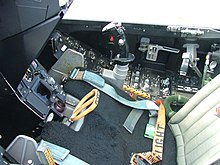|
Side-stick  A side-stick or sidestick controller is an aircraft control stick that is located on the side console of the pilot, usually on the righthand side, or outboard on a two-seat flightdeck. Typically this is found in aircraft that are equipped with fly-by-wire control systems.[1] The throttle controls are typically located to the left of a single pilot or centrally on a two-seat flightdeck. Only one hand is required to operate them; two handed operation is neither possible nor necessary. PrevalenceThe side-stick is used in many modern military fighter aircraft, such as the F-16 Fighting Falcon, Mitsubishi F-2, Dassault Rafale, and F-22 Raptor, F-35 Lightning 2, Chengdu J-20, AIDC F-CK 1 Ching-Kuo and also on civil aircraft, such as the Sukhoi Superjet 100, Airbus A320 and all subsequent Airbus aircraft,[2] including the largest passenger jet in service, the Airbus A380. It is also used in new helicopter models such as the Bell 525. Compared to centre sticksA side-stick arrangement contrasts with the more conventional design where the stick is located in the centre of the cockpit between the pilot's legs, called a "centre stick". A side-stick arrangement allows HOTAS and increases ejection seat safety for the pilot as there is less interference amongst flight controls.[citation needed] Handling of dual input situationsIn Airbus' implementation, input values of both side-sticks are normally added up,[3] except when the "priority takeover button" is held down. In such a scenario, any inputs on the other side-stick will be ignored.[4] Holding this button down for a minimum of 40 seconds will result in the other side-stick being disabled. This can reversed by pressing the button on either side-stick again. A green light will activate on the side of the pilot currently on control. In contrast, on the side of the other pilot, a red light will turn on to indicate that their side-stick's inputs are being ignored.[5] While the inputs are added up, the sum is clamped to the value of the maximum possible deflection a single side-stick;[6] but this still means that when both side-stick are deflected 50% in the same direction, the resulting effective input will be that of a fully deflected side-stick, despite neither one being deflected over 50%. In addition, because the inputs are added up, any deflection of the other side-stick in the opposite direction will in effect be subtracted, resulting in the inputs partially cancelling each other out. In fact, if two inputs have opposite directions but equal magnitudes, the sum will be zero, and thus the flight control surfaces would remain in their current positions. In addation to visual indications,[7] detection of more than a single side-stick deflection greater than 2°[8] from neutral without the priority takeover button being held down results in an aural "DUAL INPUT" warning being played every five seconds.[9] Due to this aural warning having the lowest priority, it will not be played if there are warnings with a higher priority, such as those from the EGPWS, as those will take precedence,[10] posing a potential risk for pilots. Examples of this occurring include the 2009 crash of Air France Flight 447 (an Airbus A330 flying from Rio de Janeiro to Paris), the 2010 crash of Afriqiyah Airways Flight 771 an Airbus A330 from flying Johannesburg to Tripoli[11][12] and the 2014 crash of Indonesia AirAsia Flight 8501 (an Airbus A320 flying from Surabaya to Singapore).[13][14]. Comparison of passive and active side-sticksPassive side-sticksIn the centre stick design, like traditional airplane yokes, both the pilot flying, PF's, and pilot not flying, PNF's, controls are mechanically connected together so each pilot has a sense of the control inputs of the other. In aircraft with passive side-sticks, on the other hand, they and move independently from each other, and do not offer any haptic feedback on what the other pilot is inputting. This can lead to "dual input" situations, which should be avoided. To see how dual input situations are handled, see § Handling of dual input situations Active side-sticksHowever a later, significant, development is the 'active' side-stick,[15] which is in the new Gulfstream G500/G600 series business jet aircraft. In this system, movements in one side-stick produce the same actions in the other side-stick and therefore provides valuable feedback to the other pilot. This addresses the earlier criticisms of the 'passive' side-stick. The 'active' side-stick also provides tactile feedback[16] to the pilot during manual flight. In fact the three largest avionics manufacturers, Honeywell, Rockwell Collins and Thales,[17] believe it will become the standard for all new fly-by-wire aircraft. In 2015 Ratier-Figeac as a subsidiary of UTC Aerospace Systems, and supplier of ‘passive’ side-sticks to Airbus since the 1980s[18] became the supplier of ‘active’ side-sticks for the Irkut MC-21.[19] This is the first airliner to use them. Such an active side-stick can also be used to increase adherence to a safe flight envelope by applying a force feedback when the pilot makes a control input that would bring the aircraft closer to (or beyond) the borders of the safe flight envelope. This reduces the risk of pilots entering dangerous states of flights outside the operational borders while maintaining the pilots' final authority and increasing their situation awareness.[20] See alsoAccidentsReferences
External links
|